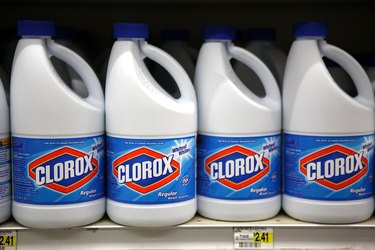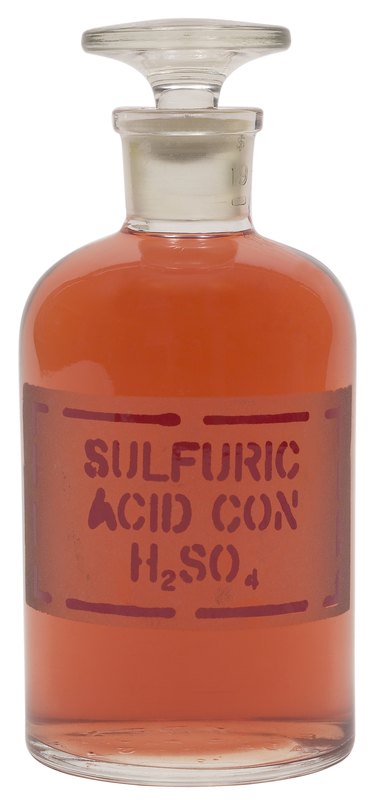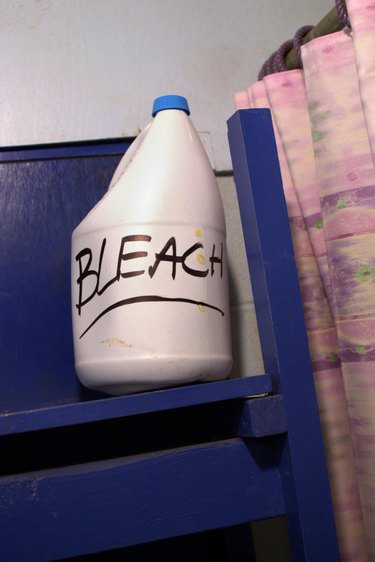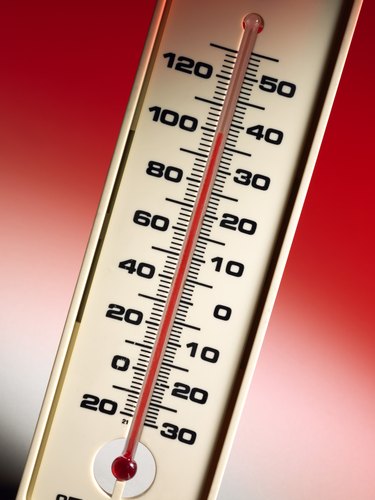
Common household chemicals serve as a reminder of chemistry's direct effect on our daily lives. The most common household chemicals improve our lives by allowing us to quickly and efficiently clean, degrease and sanitize. However, many useful chemicals are also dangerous. Become familiar with the hazards and applications of common household chemicals and use the ones that are right for your home.
Sulfuric Acid
Video of the Day

Sulfuric acid is a primary and secondary ingredient in many household cleaners and home maintenance products. One of the most common examples of sulfuric acid in the home is drain cleaner; liquid-form drain cleaners that unclog drains often contain sulfuric acid. In lesser concentrations, sulfuric acid occurs in glass-cleaning etching compounds, rust and corrosion dissolvers and some fabric cleaners. In high concentrations, sulfuric acid immediately burns human skin upon contact and the fumes from liquid and aerosol forms of sulfuric acid cause respiratory damage. Do-it-yourselfers should wear eye, respiratory and skin protection when working with household products that contain high concentrations of sulfuric acid.
Video of the Day
Sodium Hydroxide

Sodium hydroxide, also called "lye," occurs in household products ranging from toiletries, such as toothpaste and hair dye, to cleaning products, such as detergents and stain removers. Although not hazardous to the skin in the case of toiletries, high concentrations of sodium hydroxide cause severe chemical burns. The most common examples of hazardous concentrations of sodium hydroxide are oven cleaners and drain cleaners. In solid, crystal form or concentrated, liquid solutions, sodium hydroxide burns can cause serious burns and even leave permanent scarring. Eye contact with solid or solution sodium hydroxide can lead to blindness. When using household cleaners that contain hazardous amounts of sodium hydroxide, you must wear gloves, skin and eye protection.
Chlorine Bleach

Although many bleach compounds exist, chlorine bleach is the most common type found in household products. Manufacturers often market chlorine bleach simply as "bleach" and its applications range from color and stain removal to cleaning and disinfecting. Suppliers typically offer household bleach in powder or liquid form. Skin contact with chlorine bleach causes irritation in some individuals and eye contact and ingestion both pose health dangers. The gases resulting from a combination of bleach and ammonia or bleach and acidic compounds typically produces hazardous fumes.
Mercury

Although mercury is well-known as a toxic and hazardous compound, its presence in the home often goes unnoticed. The most obvious instances of mercury in the home are thermometers and thermostats, such as those on a furnace or air-conditioning unit. Additionally, fluorescent light fixtures contain mercury, including the popular compact fluorescent lamp. The effects of exposure to large amounts of mercury or prolonged exposure to smaller amounts of mercury include significant pulmonary, respiratory and central nervous system damage.